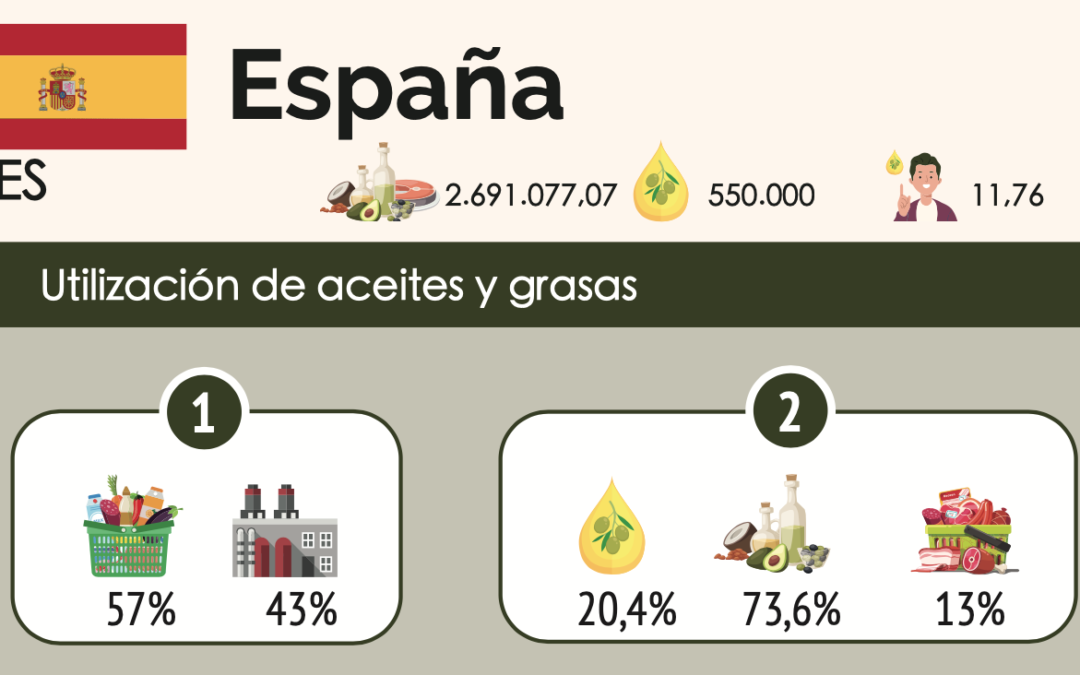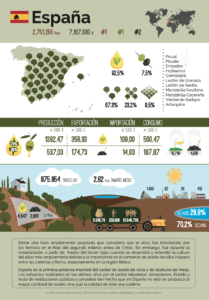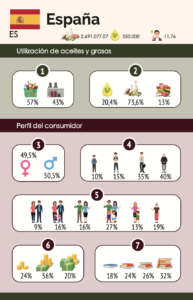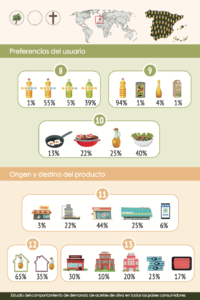Spain is the world’s leading power in the olive oil and table olive sector. The efforts made in recent years by the sector (olive growers, millers, the State and other public and private institutions) have meant that Spain not only produces the largest quantity of oil, but also that the quality is unsurpassed. Spanish production represents nearly 60% of EU production and 45% of world production.
It is the leading producer of olive oil, and only Italy has displaced it from first place for a few short periods of time. The contrast between a decreasing surface area and a growing production shows that the Spanish olive grove has been undergoing a renewal process which is leading to an increase in its productivity.
It has 2,751,255 hectares of cultivated area and produces 7,167,830 tons of table olives. Among its crops, the most predominant is traditional cultivation (67.3%), followed by intensive (23.2%) and super-intensive (9.5%) plantations. In addition, 29.8% of the plantations are irrigated and 70.2% are rainfed.
The Spanish olive grove is present in 34 provinces of the 13 autonomous communities. The distribution of the crop among the different autonomous communities has significant differences. It is mainly found in Andalusia, producing around 75% of the national production and contributing a quarter of the world production.
The main producing area is located in the diagonal that joins the Northwest of Jaén with the Southeast of Seville, which includes the Subbética of Córdoba, the North of Málaga and the West of Granada. In these areas, there is a great variety of olive trees that cover the entire Andalusian lands and give rise to exceptional oils of extraordinary quality. The most important olive varieties in Spain are Picual, Picudo, Empeltre, Hojiblanca, Cornicabra, Lechín, Manzanilla, Verdial and Arbequina.
Approximately 92% of the olives produced are milled for oil extraction and only 8% are used for table olives. It produces 1,392,470 tons of olive oil and 537,030 tons of table olives per year. It is the world’s leading exporter of olive oil, selling 358,930 tons of olive oil and 174,730 tons of table olives abroad. Seventy percent of olive oil production corresponds to high quality oil (virgin or extra virgin) and 30% to a lower quality (lampante). The percentage of olive oil obtained from each kilo of olives is 21%.
It has 975,954 olive grove plots, of which the average size corresponds to 2.82 hectares. In Andalusia, the provinces of Seville and Cordoba are the ones with the largest average farms. However, it is in Almeria where the average farm is smaller. Productivity per hectare is 0.547 tons of olive oil and 2.605 tons of table olives.
The turnover generated by the olive sector is around five million euros, and the annual number of working days in the olive sector and related industries is more than fifty million.
Spain is the country with the largest number of mills, olive oil mills, refineries and vatting plants, with 1,830, 52, 25 and 413, respectively.
In addition to being the world’s leading producer, Spain is the world’s leading consumer of olive oil. A total of 550,000 tons of olive oil are consumed, which corresponds to 20.4%. Annual per capita consumption is 11.76 liters.
As for the consumer profile in Spain, the male sex accounts for 50.5% and the female sex for 49.5% of consumption. The highest consumption is by people over 65 years of age (40%), followed by people between 50 and 65 years of age (35%). The age range where consumption is lowest is under 34 years of age (10%). According to the family structure, middle-aged families with children consume the highest proportion of olive oil (27%), followed by young families with children (16%), as well as middle-aged families without children (16%), where consumption is lower in young families without children (9%).
According to the level of income, families with a medium income level are those in which the consumption of olive oil is higher than those with low or high income levels, standing at 56%. The Spaniards who have higher levels of education, such as university education, consume a higher percentage of olive oil than those who have lower levels of education, at 32%. Those people who do not have studies thus consume a lower amount of olive oil.
According to the different existing categories of oil, Spaniards prefer to consume olive oil (55%), followed by extra virgin olive oil (39%). The least consumed olive oil is olive pomace oil (1%).
The PET container is consumed in a fairly significant proportion among Spaniards, accounting for 94%.
In the Spanish population, the consumption of olive oil is widespread in different areas of the kitchen. The greatest use of olive oil among the population is in crude oil. It is used to season salads, accounting for 40%. Olive oil is practically the only vegetable oil that can be consumed crude.
The largest olive oil purchases by establishment are in supermarkets (44%), followed by hypermarkets (25%). The purchase of olive oil through the Internet amounts to 6%. Less than 2% of the sales of bottled olive oil in Spain are made directly by the cooperatives. The rest, almost all that is produced, is sold in bulk to other companies that store, package and place it on the market through traditional distribution (hypermarkets, supermarkets…). Mercadona alone sells more than 200 million liters of olive oil, bottled mostly by the Portuguese company «Sovena», which in turn buys the product in bulk from several cooperatives and oil mills. This is more than 13 million 5-liter carafes sold under its white Hacendado brand, some 8,500 in each of its 1,500 supermarkets, which gives an average of 30 carafes a day in each of them. In other words, almost half of the olive oil consumed in Spain is sold by Mercadona. The other half is sold in the rest of the supermarkets under private labels and the brands of large distribution companies such as Dcoop, Deoleo, Acesur, etc.
Olive oil consumption is more predominant inside the home (65%), although consumption outside the home is especially relevant (35%), which could be translated into 360,000 tons inside the home and 190,000 tons outside the home. In the latter, the most predominant establishments are bars and restaurants (30%), followed by the canning industry (23%) and hotels (20%).
Olive oil is one of the most prestigious edible oils in Spain. It is one of the engines of our economy, as it gives a lot of life to our towns. Moreover, one out of every two bottles of oil consumed in the world is Spanish olive oil.
Almost 70% of the oils marketed in Spain are exported to more than 175 countries, especially in the EU.




